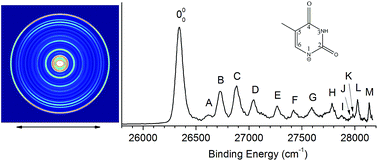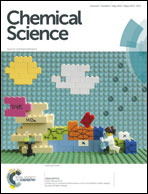Probing the vibrational spectroscopy of the deprotonated thymine radical by photodetachment and state-selective autodetachment photoelectron spectroscopy via dipole-bound states†
Abstract
Deprotonated thymine can exist in two different forms, depending on which of its two N sites is deprotonated: N1[T–H]− or N3[T–H]−. Here we report a photodetachment study of the N1[T–H]− isomer cooled in a cryogenic ion trap and the observation of an excited dipole-bound state. Eighteen vibrational levels of the dipole-bound state are observed, and its vibrational ground state is found to be 238 ± 5 cm−1 below the detachment threshold of N1[T–H]−. The electron affinity of the deprotonated thymine radical (N1[T–H]˙) is measured accurately to be 26 322 ± 5 cm−1 (3.2635 ± 0.0006 eV). By tuning the detachment laser to the sixteen vibrational levels of the dipole-bound state that are above the detachment threshold, highly non-Franck–Condon resonant-enhanced photoelectron spectra are obtained due to state- and mode-selective vibrational autodetachment. Much richer vibrational information is obtained for the deprotonated thymine radical from the photodetachment and resonant-enhanced photoelectron spectroscopy. Eleven fundamental vibrational frequencies in the low-frequency regime are obtained for the N1[T–H]˙ radical, including the two lowest-frequency internal rotational modes of the methyl group at 70 ± 8 cm−1 and 92 ± 5 cm−1.


 Please wait while we load your content...
Please wait while we load your content...